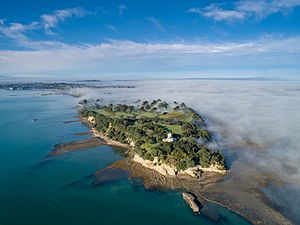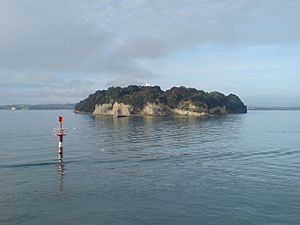Musick Point / Te Naupata facts for kids
Musick Point is a special piece of land that sticks out into the water in Bucklands Beach, a suburb of Auckland, New Zealand. It's also known as a headland. This land forms the eastern side of the Tamaki River.
The point was named in 1942 after Ed Musick, a brave aviator (airplane pilot) who visited New Zealand in 1937. But it also has an older Māori name, Te Waiarohia, which was once a strong Māori fort. Today, Musick Point is home to a golf club and a historic building called the Musick Memorial Radio Station.
This whole piece of land, called Te Naupata in Māori, reaches out between the Motukorea Channel and the Tamaki Strait. The nearby areas of Bucklands Beach and Eastern Beach are just to the south.
Contents
History of Musick Point
Early Māori Life at Te Waiarohia
Long ago, the Māori of the Ngai Tai tribe (called an iwi) lived on this headland. They built a strong fort called Te Waiarohia Pā (sometimes known as Te Naupata Pa). They dug a big ditch across the land to protect their home.
In 1821, another tribe called the Ngapuhi took over the pā. You can still see parts of the old ditch today. The beaches and the sea around Musick Point were very important. They provided lots of food for the people living there.
Land Changes and New Uses
In 1836, a missionary named William Thomas Fairburn bought a large area of land, including Musick Point. He traded 90 blankets, tools, money, tobacco, and combs for about 40,000 acres (162 square kilometers). Later, this land was divided and sold to others. Early settlers called it East Head.
Today, Musick Point is a popular place for many activities. People enjoy walking, taking wedding photos, and looking out over the harbour. It's also a great spot for fishing and playing golf.
Musick Memorial Radio Station
Building a Special Radio Station
Musick Point is home to the Musick Memorial Radio Station. This building was opened in 1942. It has a cool design called Streamline Moderne, which looks like it's ready for speed. The station was built to talk to ships and airplanes using radio signals. It was the main place for maritime (sea) radio, called Auckland Radio ZLD, and aviation (air) radio, called ZLF.
Musick Point was a perfect place for a radio station. It was far away from cities, so there was no electrical interference from things like electric trams. This meant the radio signals could be heard clearly. The old radio station in downtown Auckland had a lot of problems with interference. The powerful transmitters (which send out signals) for the station were built a few kilometers away in Bucklands Beach. Operators at Musick Point controlled them from a distance.
Changes Over Time
At first, the New Zealand Post Office ran ZLD and ZLF. Later, the Civil Aviation Corporation took over the aviation radio service (ZLF) and moved it to Auckland Airport. Then, Telecom NZ Ltd took over Auckland Radio (ZLD). Today, Spark still uses the building for cellular services (like cell phone towers).
During World War II, a secret radio bunker was built about 300 meters south of the main building. This was a backup in case the main station was bombed. Because the area was isolated, a water tower was also built. It stored water for the small group of houses and workers' accommodation built nearby.
The Radio Group Today
In 1993, all New Zealand coast radio stations closed. But the equipment from Auckland Radio ZLD was saved by a group called the Musick Point Radio Group. This group is non-profit and includes many people who used to work at Musick Point.
The group now has a long-term lease on the building. They have brought the station back to life for amateur (ham) radio users. They use some of the old ZLD transmitters and new equipment. In 2003, the station was recognized for its important "engineering heritage value."
To honor the station's history, the group uses the amateur radio callsigns ZL1ZLD and ZL1ZLF. They also have a radio museum inside the building. You can even hear a low-power FM radio station that shares information about Musick Point. The group used to keep an old marine radio frequency (512 kHz) alive, but this stopped in 2013 when new amateur radio bands became available.




